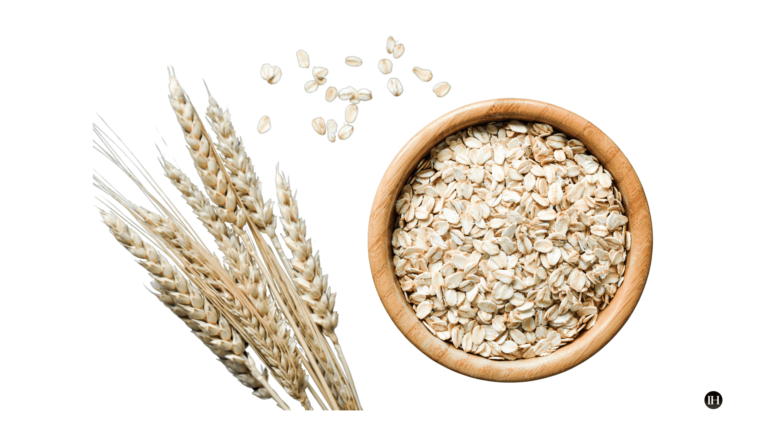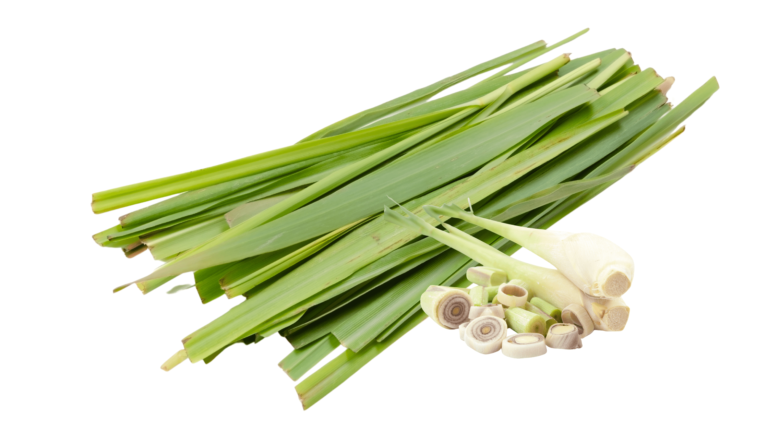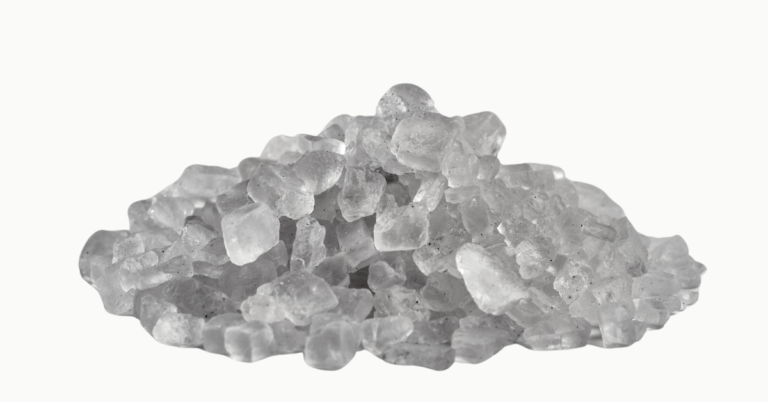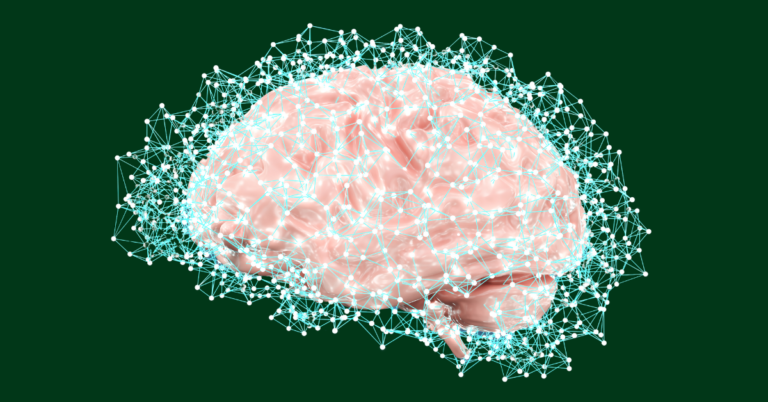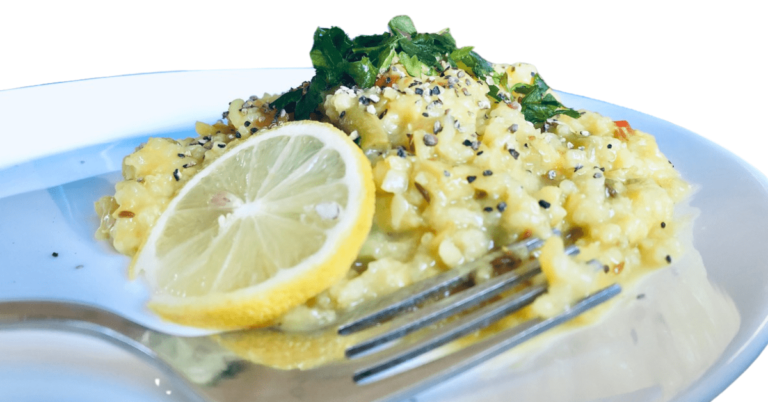Muscle Recovery Better With Lemon Verbena: Why?
Muscle recovery is crucial in transforming one’s physical structure through training. As individuals, we have the ability to restructure our bodies.
Exercises such as weight training, yoga, running, or high-intensity interval training can trigger muscle changes. Proper diet and staying hydrated are essential for post-workout muscle recovery.
Adding micro components and bioactive compounds from plant sources to a daily routine can have accumulative effects on supporting muscle quality.
Key Point In This Article
- This article discusses the Lemon Verbena plant and its bioactive compounds, including the role of active compounds found in plants, specifically their medicinal and therapeutic properties in muscle recovery.
- It also provides an overview of muscle behaviour and explores the concept of an open window period after strenuous exercise.
- Additionally, it covers the methods of using these compounds, helpful case studies, and other plants that can support muscle health for a more comprehensive overview.
Muscle Activation & Behaviour
Repeatedly engaging a muscle beyond its typical day-to-day functions results in contraction and inflammation due to systematic pressure.
This can be deemed muscle behaviour, such as lifting weights in a controlled and methodical manner.
Furthermore, when muscle begins to adapt or respond, we can visually see differences and feel them internally.
Diet intake, including solids and liquids, is pivotal to muscle behaviour. Food and liquids have a substantial impact on helping muscle recovery.” I.e., Recovery and Growth Diet.”
One aspect of diet that is not understood nearly as well as macros is the intake of bioactive compounds through natural foods, such as the high-quality effects of polyphenolic compounds.
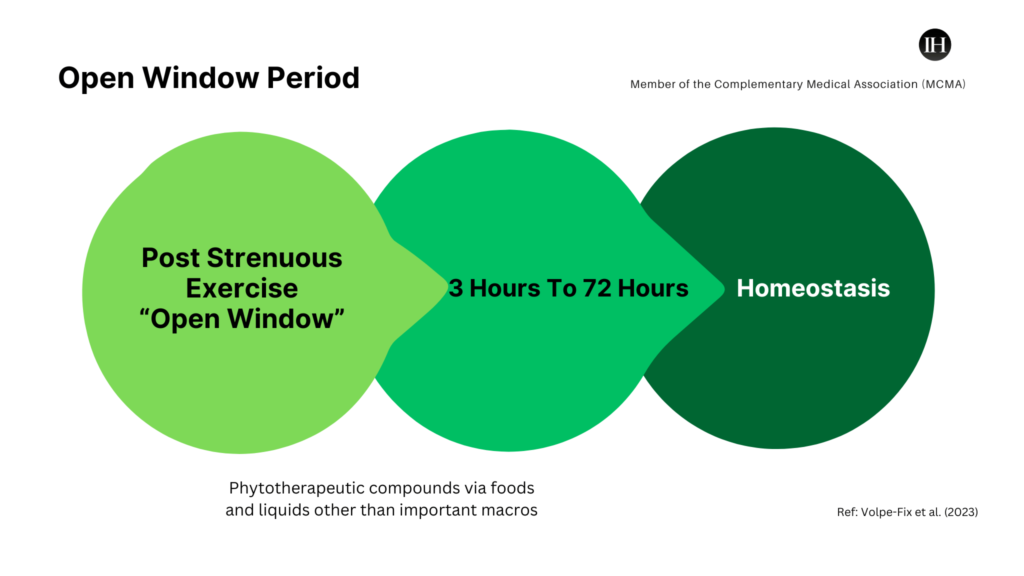
Importance Of The Open Window Period
After strenuous exercise, the body undergoes a period where it is more receptive to nutrient uptake.
This period is called the “open window period,” a crucial interception point and an opportune time to consume foods that can assist in recovery.
Therefore, optimising nutrient intake during this time can be important for supporting effective recovery.
Integrating Daily Support & Open Window To Maximize Recovery
However, it is also widely accepted that a methodical daily diet is more impactful than singular ‘open window period’ feeding.
For instance a diet that contains high quality macros, micros and compounds in a consistent manner.
The open window period, however, plays an important role in supporting the body during its window of change and, when accounted for in a complete diet & liquids routine, can optimise muscle recovery further.
- Ie; an appropriate diet combined with phyto therapeutic (tisane) teas, anti-inflammatory plant sources etc.
Behaviour Of The Open Window Period
According to Volpe-Fix et al. (2023), the ‘Open Window’ period is related to the moment after exhausting exercises, which can last from 3 h to 72 h, depending on the parameters analysed.
A lower immune system functionality is observed, increasing the risk and probability of opportunistic infections, mainly upper respiratory tract infections (URTIs).
Role of Medicinal Compounds: Plant Phytochemicals
Several plant sources contain numerous therapeutic compounds, which, when added as part of a frequent diet plan, accounting for open window periods, can play a substantial role in developing muscle longevity.
Metaphorically, the difference can be “real gold” rather than “gold plated.”
For instance, the compound curcumin, found in turmeric, is a potent anti-inflammatory and antioxidant, counteracting internal inflammation.
Similarly, the plant Lemon Verbena is associated with anti-inflammatory effects, which this article examines in the latter sections.
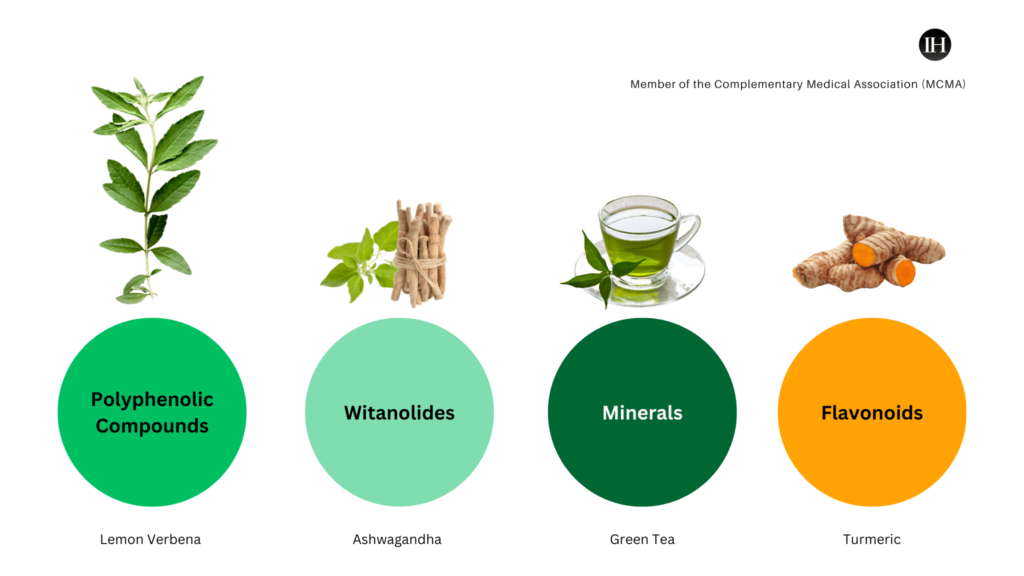
Muscle Recovery “Post Training” Growth & Gain
Post-training muscle activation continues during muscle recovery. Usually, muscle recovery involves soreness, tenderness, stiffness, and occasional pain.
Here are a few points on general muscle recovery:
- Muscle recovery can occur after various activities, such as exercise, physical work, or sitting in one position for an extended period (different from physical exercise).
- This involves a muscular response in the context of methodical and systematic exercise or training. Which, in essence, is the body’s process of change.
- Natural compounds can be more body-friendly and can provide several therapeutic effects involving matrix-like nutrition, depending on how they’re consumed.
Many individuals follow the “no pain, no gain” principle to achieve remarkable physical structures by working hard. Understanding that physical growth is undeniably interlinked with the body’s internal chemistry is crucial.
Furthermore, “recovery capacity” is influenced substantially by dietary nutrition and hydration.

Why Natural Sources Of Nutrition Are Body-Friendly
Jaime and Santoyo (2021) explain in “The Health Benefits of the Bioactive Compounds in Foods” that our body prefers natural bioactive compounds.
In particular, the reasons why our body accepts natural foods are due to the digestion process, intestinal absorption, bioavailability rates, etc. The quality of food matters including how it is prepared.
For instance a bowl of sprouted mung bean, according to (in-vivo) study may be rapidly distributed and absorbed by the body. Which means inline with the open window period this makes it a good source of nutrition as it has a substantial profile including important compounds such as vitexin.
Traditional Sciences On Muscle Diets
Moreover, if we focus on traditional and ancient sciences like Ayurvedic science and TCM, we can see how the significance of BCs (bioactive compounds) has never been ignored.
The usage, application, comprehension, and examination of BCs have been intensified as the modern world develops.
Nowadays, the insights of these sciences are becoming increasingly congruent with contemporary requirements.
Study: Understanding Muscle Recovery Behavior
To understand how muscle behaves post strenuous exercise, points from a study by Mielgo-Ayuso and Fernández-Lázaro’s (2021) in the journal Nutrients are examined;
“how muscles recover after exercise due to the damage and inflammation caused by physical activity”
Study Key Points
The study found that exercise-induced muscle damage triggers a series of responses in the body, including inflammation and oxidative stress, which can lead to muscle soreness and reduced muscle function.
During recovery, the body works to repair this damage and reduce inflammation, improving muscle function and performance over time.
Adequate nutrition and liquid enable muscle recovery after exercise.

Summary Of Insights Muscle Recovery
The typical signs of muscle recovery after strenuous exercise may include discomfort around the areas of the muscle and in other parts of the body.
- For instance, a dull ache, stiffness, sensation of heat (inflammation), fatigue or even sharp intermittent aches. Short term difference in range of muscle movement, sensation of muscle tightness and may vary depending on the individual etc.
- Muscle soreness and recovery are two sides of the same coin in relation to post strenuous exercise.
- Mental Stamina: Without proper recovery, an increased risk of negative muscle burn out can hinder progress. An element of mental strength is also tested in pre and post-strenuous exercises, which may benefit from regulating breath through meditative techniques.
Note: A muscle injury due to underlying health concerns as opposed to muscle soreness after strenuous exercise is different. In this respect, this article is limited to post-exercise muscle recovery only.
The second half of this article examines the plant Lemon Verbena in muscle recovery.
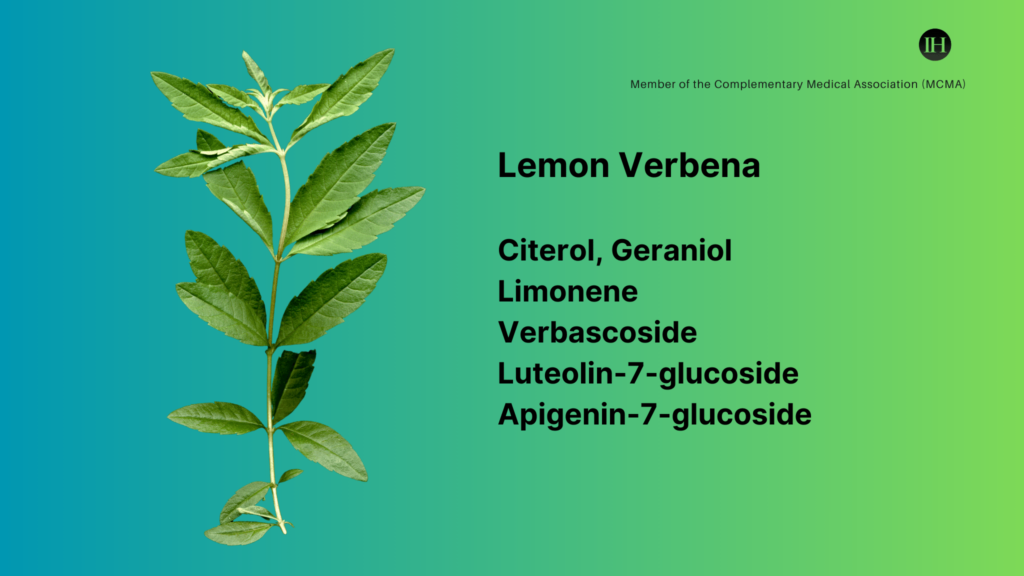
Lemon Verbena (Lippia Citriodora)
Aloysia citrodora (Lippia citriodora), commonly known as Lemon Verbena, is a fragrant plant native to South America.
Here are some of its key physical characteristics:
- The plant has long, pointed leaves with a glossy texture.
- Crushing its leaves emits a robust, lemony aroma.
- Lemon Verbena use in traditional medicine dates back to earlier periods. Some areas of use include helping symptoms of digestive issues, anxiety, insomnia, etc.
- The earliest recorded use of lemon verbena in traditional medicine dates back to the 18th century. Older than this, ancient references include the Peruvian Incas, who used it to treat fever and other illnesses.
The plant is used in phytotherapeutics in several areas today—muscle recovery, digestive aid, therapeutic tea anti-inflammatory and several other uses.
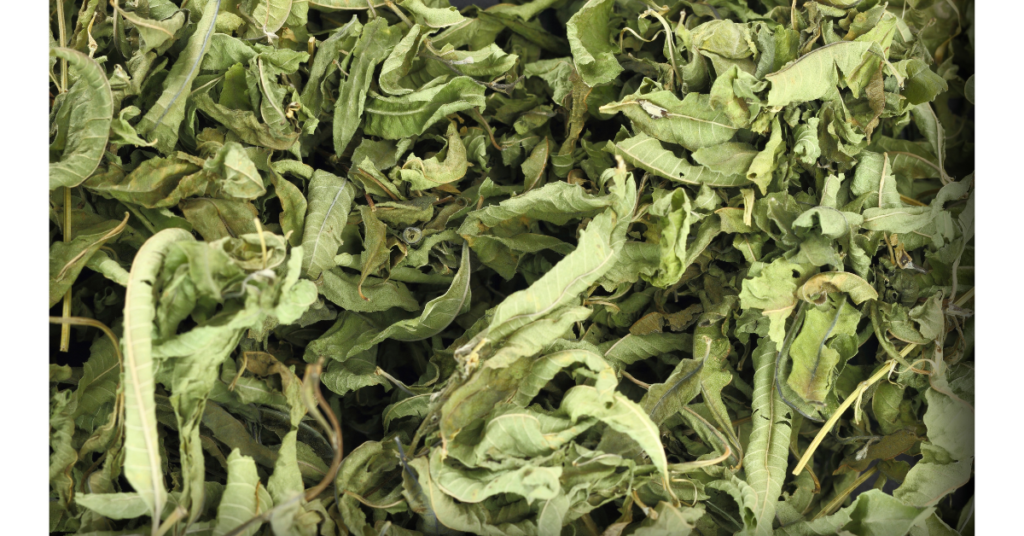
Lemon Verbena: Bioactive Compounds
The plant contains several bioactive compounds known as phytochemicals associated with anti-inflammatory and antioxidant effects.
Here are some of its main compounds according to Buchwald-Werner et al. (2018):
- Citerol, geraniol, limonene; exhibit anti-inflammatory actions on muscles, which can help reduce muscle soreness and inflammation.
- Verbascoside; anti-inflammatory properties and has been shown to reduce oxidative stress
- Luteolin-7-glucoside; found to decrease the levels of inflammatory cytokines in muscle cells, which is beneficial for reducing muscle damage and promoting recovery.
- Apigenin-7-glucoside; found to increase the activity of antioxidant enzymes, such as catalase and superoxide dismutase, which help to reduce oxidative stress in muscles.
These compounds have a matrix-like effect as they are not isolated but part of the whole plant composition.
Lemon verbena tea has aromatic and polyphenolic compounds associated with antispasmodic activity. This means that it can help to alleviate muscle spasms and cramps, Carnat et al. (1999).
A Case Study On Lemon Verbena Effects
Furthermore, Buchwald-Werner et al. (2018) study, focused on the effects of lemon verbena extract supplementation on muscle strength and recovery after exhaustive exercise.
The authors state that it was a randomised, placebo-controlled trial. It included participants randomly assigned to either treatment group:
- Lemon verbena extract supplementation or, a control group (placebo).
- The participants were healthy, non-smoking, ages 22-50, moderately active (exercise 1–3 times per week), male and female, ate a balanced diet including fruit & vegetables, and had a BMI between 19 and 30 kg/m2.
- Specifically, the participants who took the lemon verbena extract supplement experienced less muscle soreness and fatigue after the exhaustive exercise test.
Assessment Of Biomarkers
After exercising, participants’ muscle recovery was measured by assessing various biomarkers. The biomarkers included creatine kinase levels and recovery after exhaustive exercise.
Some of the parameters included the following:
| Biomarker Assessed | Observation Method |
|---|---|
| Muscle strength & Muscle soreness | Visual analog scale (VAS) & Wingate test |
| Creatine kinase (CK) levels | Blood test |
| Lactate dehydrogenase (LDH) levels | Blood test |
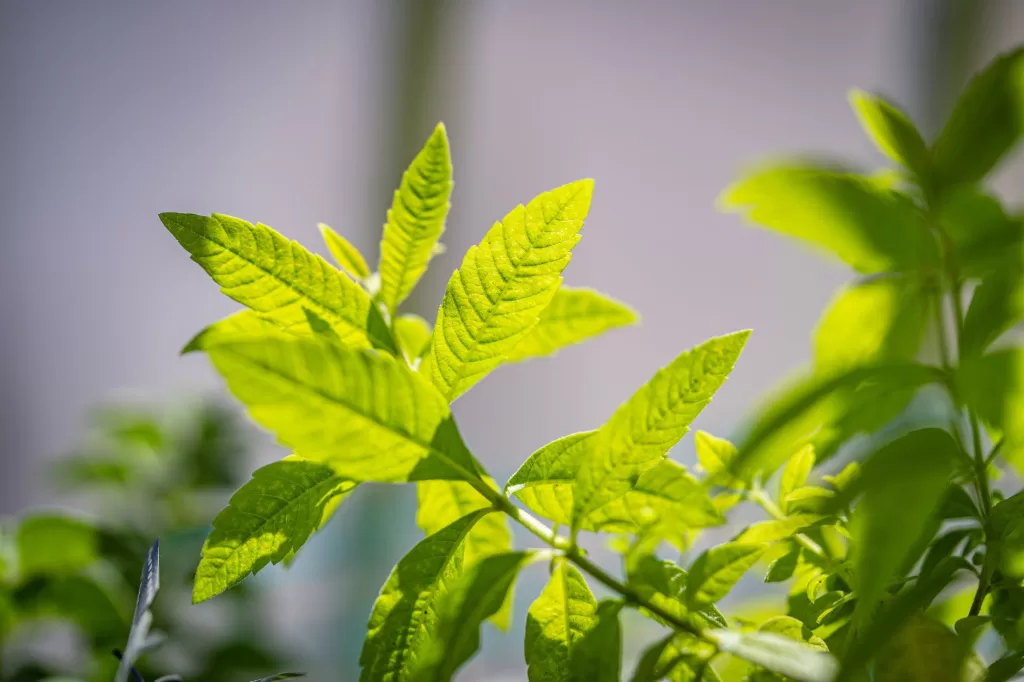
Creatine Kinase Enzyme
Creatine kinase is an enzyme. The enzyme is released into the blood when muscle damage occurs.
Because of this, measuring these levels is a common way to assess muscle damage and recovery. This is quite common in sports and athletic fields.
The former study found that supplementation with lemon verbena reduced creatine kinase levels, indicating improved muscle recovery.
However, adding to this, considering the ‘rest’ period, diet, hydration, body type and type of exercise when factoring in muscle recovery referenced in this study is crucial. Based on this, the effects can be variable.

Method & Dose In Study
- The participants took a proprietary lemon verbena extract supplement OR a placebo for a total of 21 days.
- The LV extract contained 400 mg per capsule of a particular brand.
- Participants took two capsules per day (800mg/day).
- Furthermore, the study also included a 5-day washout period before the start of the implementation phase.
The complete study by Buchwald-Werner et al. (2018) can be found by clicking on this link.
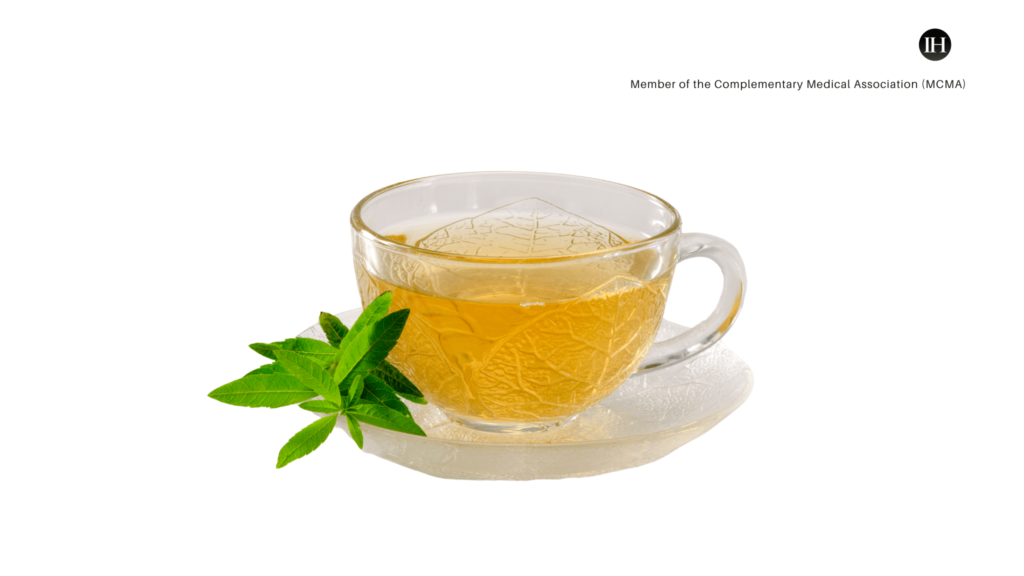
Therapeutic Tea Made From Lemon Verbena
Furthermore, drinking the leaf tea made from organic Lemon Verbena is another beneficial way to incorporate it into an ongoing recovery routine, adding to hydration levels etc.
It is important to choose a source that is free from chemical pesticides to ensure the purity and quality of the tea.
To prepare a cup of lemon verbena tea (herbal therapeutic);
- Use clean boiling water in a kettle or pot. Following this, take 1-2 tsp of dried lemon verbena leaves and place them in a tea strainer or infuser.
- Subsequently, put the strainer or infuser in a mug and pour the hot water over it. Allow the tea to steep for 3-5 minutes, depending on how strong you prefer it.
- Once the tea is ready, remove the strainer and sip warm. Generally, Lemon verbena tea can be consumed at any time of day, morning or in between meals for generally healthy individuals.
Note: Tea should be consumed based on individual health status and suitability.
Other Muscle Recovery Plant Sources
Other than Lemon Verbena, Ayurveda and other sciences report the existence of several other plants that have similar properties.
Similar results were found in other studies investigating the effects of natural ingredients on muscle strength and muscle damage; citing some of the following:
- Ashwagandha: A compound called withanolides, is shown to help in muscle recovery and growth.
- Turmeric: Curcumin, a compound found in turmeric, is shown to have anti-inflammatory properties.
- Ginger: Gingerol, a compound found in ginger, can aid in muscle recovery by reducing inflammation and promoting circulation.
- Blueberry: The compound called anthocyanin in blueberries has been found to aid in muscle recovery after exercise.
These plants are rich in polyphenols, a quality that lemon verbena possesses.
Summary
Intense exercise often leads to soreness, tenderness, dull aches, and tightness during recovery. Muscle recovery may benefit from Lemon Verbena therapeutic properties when used systematically.
- Considering the composition of Lemon Verbena, its traditional usage, and the results of contemporary case studies, incorporating this plant into a systematic routine could prove beneficial for individuals engaging in strenuous exercise, provided it is suitable.
- Muscle soreness benefits from a personalised and methodical plan, primarily if it is caused by strenuous exercise. This involves a personalised diet, activity, rest, stretching, topical application such as hot or cold bathing etc.
- As a result, Lemon Verbena may be a suitable source to explore for individuals who need natural sources for muscle recovery support after strenuous exercise. Reputable studies suggest that Lemon Verbena is generally well-tolerated.
Precautions & Suitability
Precautions and personal responsibility are crucial. Check the suitability of any therapeutic diet or well-being routine for any person, pregnant or chronic health concerns. Seek the advice of a professional. If muscle soreness is unrelated to physical exercise, severe or lasts for an extended period, seek medical advice.
This is an informational post only and does not constitute professional advice.
- Buchwald-Werner, S., Naka, I., Wilhelm, M., Schütz, E., Schoen, C., & Reule, C. (2018). Effects of lemon verbena extract (Recoverben®) supplementation on muscle strength and recovery after exhaustive exercise: A randomized, placebo-controlled trial. Journal of the International Society of Sports Nutrition, 15. https://doi.org/10.1186/s12970-018-0208-0
- Hunjan. MCMA. CPD certified (COE), 2020, 2021 (London, United Kingdom). InteGratiiveHealth.com, (author).
- Jaime, L., & Santoyo, S. (2021). The Health Benefits of the Bioactive Compounds in Foods. Foods, 10(2). https://doi.org/10.3390/foods10020325
- JMielgo-Ayuso, J., & Fernández-Lázaro, D. (2021). Nutrition and Muscle Recovery. Nutrients, 13(2). https://doi.org/10.3390/nu13020294
- Polumackanycz, M., Petropoulos, S. A., Añibarro-Ortega, M., Pinela, J., Barros, L., Plenis, A., & Viapiana, A. (2022). Chemical Composition and Antioxidant Properties of Common and Lemon Verbena. Antioxidants, 11(11). https://doi.org/10.3390/antiox11112247
- Serna, A., Marhuenda, J., Arcusa, R., Pérez-Piñero, S., Sánchez-Macarro, M., García-Muñoz, A. M., Victoria-Montesinos, D., Cánovas, F., & López-Román, F. J. (2022). Effectiveness of a polyphenolic extract (Lippia citriodora and Hibiscus sabdariffa) on appetite regulation in overweight and obese grade I population: An 8-week randomized, double-blind, cross-over, placebo-controlled trial. European Journal of Nutrition, 61(2), 825-841. https://doi.org/10.1007/s00394-021-02678-x
- Volpe-Fix AR, de França E, Silvestre JC, Thomatieli-Santos RV. The Use of Some Polyphenols in the Modulation of Muscle Damage and Inflammation Induced by Physical Exercise: A Review. Foods. 2023 Feb 21;12(5):916. doi: 10.3390/foods12050916. PMID: 36900433; PMCID: PMC10001084.
Informational (Audible) Video: Muscle Recovery & Growth Lemon Verbena & Others
Why do Bioactive Foods positively influence muscle recovery? And, can they help physical, mental and energy levels? Read more, explaining how and why they are essential to overall well-being & development at any age.
Bioactive
Foods



